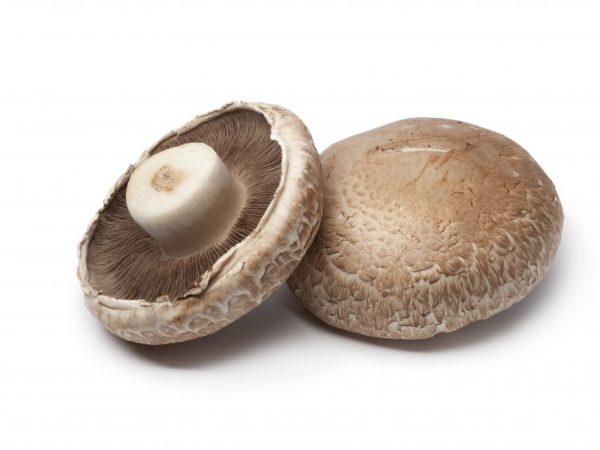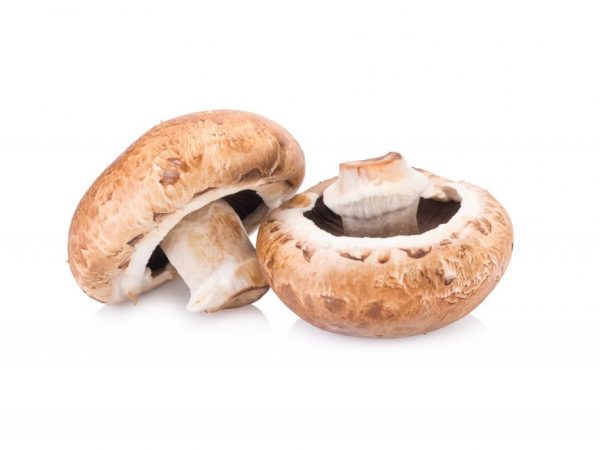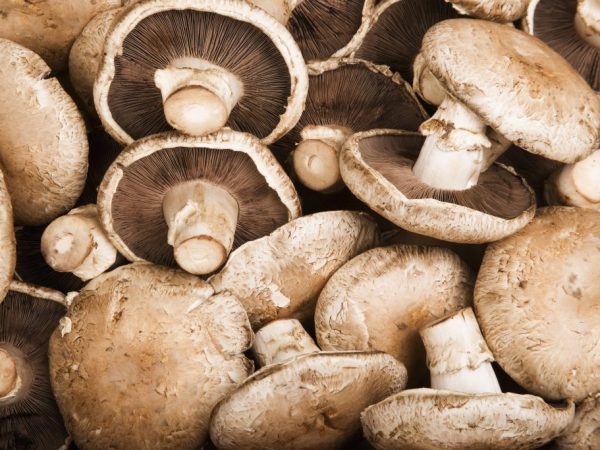Features of portobello mushroom
The Champignon family has an interesting portobello mushroom. It is little known and has long been considered unfit for food, which is due to its place of growth: in cemeteries, along roads and in pastures of cows and sheep.

Features of the Portobello mushroom
Description
This variety of champignons received its exotic name only in 1980. It was invented specifically to populate this mushroom. Because of its taste, it began to be grown artificially all over the world. Natural portobello mushrooms are rare and can only be bought in specialized stores.
Appearance Description:
- large hat (up to 15-17 cm when opened);
- the structure is dense and fleshy;
- leg up to 20-28 cm in height;
- the shape of the leg is cylindrical;
- pronounced mushroom aroma;
- the color of the cap is brown or brown;
- the plates are thin, light and frequent.
The hat opens completely, as a result of which a lot of moisture evaporates from its lower surface and the body structure becomes homogeneous, without fibers and dense. Young portobello mushrooms have a slightly pinkish flesh, which turns light beige with age.
Views
Agaricus (champignon mushrooms, which include portobello) have several species, some of which are grown artificially, while others grow in natural conditions. These include the following types of mushrooms:
- common champignon;
- sh. field;
- sh. Bernard;
- sh. two-ring;
- sh. meadow;
- sh. crooked;
- sh. trailing.
Common forest champignon
Representatives of the species are of medium size, the first representatives appear at the end of May and grow until the end of October. The cap is scaly, velvety (13-15 cm). The height of the leg reaches 11 cm. It is beige, with a characteristic ring in the middle.
The pulp is homogeneous, turns pink when cut. The plates under the cap are densely packed and have a pinkish tint, which becomes pale brown in older individuals.
Two-ring champignon

A curved cap is characteristic of mushrooms.
The double-ringed or double-stemmed champignon belongs to a species that is cultivated in many countries. On the ground without grass, it is rarely found, usually grows in open places, lawns, pastures, vegetable gardens (in general, on cultivated soil). It is characterized by a hat curved at the edges. In a young mushroom, it is almost white, and in an old one it is brown.
The stem is cylindrical and dense, thickened towards the base. The plates on the back of the cap are pale pink. The pulp is particularly juicy. The leg takes on a purple hue with age. Its height reaches 10 cm and a diameter of up to 1-3 cm. There is a formation in the form of a ring under the cap.
Curve champignon
The second name of the species is distinctly nodular champignon. It has an interesting leg - it is curved like an umbrella handle and somewhat thickened at the bottom. The hat is 13-14 cm in diameter. Its bell shape becomes flat over time, with a small bulge in the center. When pressed or in places of damage, both the leg and the cap turn yellow.
The plates are free under the cap.They are white in a young body and black in an adult.
Bernard's champignon
Has a bright aroma and beautiful appearance. A scaly beige cap, curved upwards, serves as its decoration. It is located on a high cylindrical leg (up to 15 cm), on which there is a thin light single-layer ring.
Along the head are plates, frequent and light. The pulp with a characteristic forest smell, dense and homogeneous.
Inedible species
Before harvesting a forest harvest, it is important to know which species are edible and which are poisonous. There are twins among other species and among champignons. Poisonous counterparts include:
- flat mushroom;
- sh. scaly dark (variegated);
- sh. reddish, or yellow-skinned.
Inedibles have a less dense leg, on the cut it is yellow-orange. A special feature is the smell of iodine or carbolic acid. During the cooking process, it becomes obvious and serves as an alarm signal.
Beneficial features

Mushrooms are valued for the presence of nutrients
The rare portobello mushroom is valuable for its composition, which includes:
- vitamins of group B, A, C, D, E and PP;
- trace elements (zinc, copper, manganese, selenium, etc.);
- ergosterol;
- amino acids;
- vegetable fiber;
- stearic acid;
- chitin.
The calorie content of portobello mushroom is 26 kcal per 100 g of product.
Nutritional value for 100 g of product is expressed as follows:
- Water - 92.82 g;
- Ash substances - 0.5 g;
- Dietary fiber - 1.3 g;
- Vitamins and trace elements - 5.4 g.
They are able to support the body and activate its immune system. During viral outbreaks, they serve as a natural barrier to viruses and bacteria.
Portobello is packed with protein and healthy carbohydrates, omega-6 fatty acids and the amino acids threonine and arginine. They have a beneficial effect on the cardiovascular system. Thanks to riboflamin and thiamine, they relieve migraines and headaches. They have a laxative effect and help with constipation, thanks to their fiber.
Eating them regularly lowers blood sugar and lowers cholesterol. Dried portobello mushrooms must be in the diet of people suffering from stomach diseases - they are great for ulcers. By the way. Dried portobello can also be used for hepatitis.
Harm
Excessive consumption of food causes diarrhea. The presence of chitin inhibits the digestive processes in the gastrointestinal tract. Therefore, people who have problems with the gastrointestinal tract should carefully consider the choice of foods for their diet.
Dishes with this product are considered heavy. For people with allergic reactions or individual intolerance, a preliminary consultation with a doctor is indicated. They are also contraindicated in young children.
Portobello, like other types of mushrooms, absorbs toxins and poisons from the environment, heavy metals from the air and radionuclides, which are difficult to remove completely at home. Therefore, when cooking, you should observe the exact recipe and observe the measure during the use.
Application
Portobello mushrooms are used in cooking to prepare delicious delicacies.
It is always prepared in different ways. It is good fried, stewed, or pickled. First courses have an incredible aroma that cannot be confused with anything. Portobello sauces are suitable for hot meat and fish dishes. Most often, hats are used for cooking.
So, only fleshy caps are used for baking, since the legs are not suitable due to their fibrous structure. But the legs are perfect for extinguishing.
Irina Selyutina (Biologist):
Portobello is a nutritious food. It is often called “vegetarian meat” due to its high protein content and rich meat smell. Regular use of Portobello in food allows you to remove salts of heavy metals from the body. Therefore, it is often eaten almost raw, sprinkled with lemon juice.
Interestingly, the longer the portobello is cooked, the stronger the meat smell becomes. Professional culinary experts believe that in order to achieve the best taste during cooking, the mushrooms should not be washed, but removed (scraped off) the dirt with a knife from the surface.
Especially popular in Europe are baked hats with vegetable and cheese filling, julienne, as well as combinations with fish and tomatoes. Portobello works well in combination with arugula, herbs, vegetables and dairy products.
It absorbs moisture excessively during cooking or prolonged soaking. To prevent this from happening, and the mushrooms do not lose their aroma and density, they are quickly washed under running water and cleaned of dirt and adhering foliage with a knife. Boil for no more than 10 minutes.
Conclusion
Portobello mushrooms are not common in Russia and the CIS countries. You can buy these mushrooms only in specialized stores. The species is widely used in cooking.
When collecting its relatives, you need to know the description of the species, so as not to take poisonous twins.


